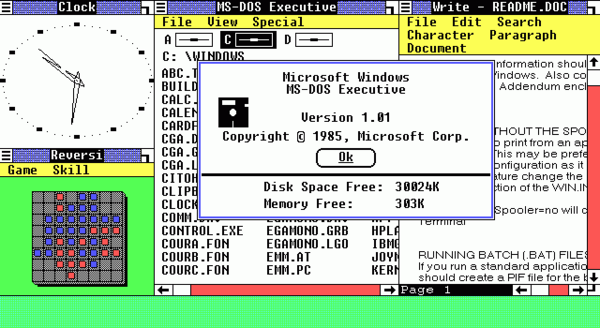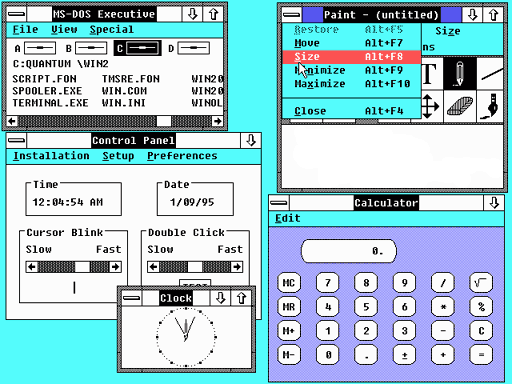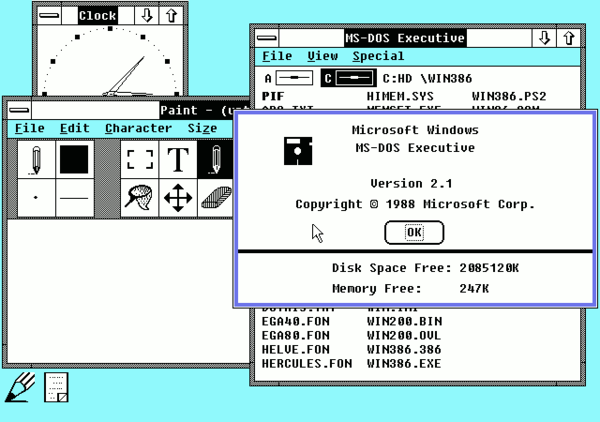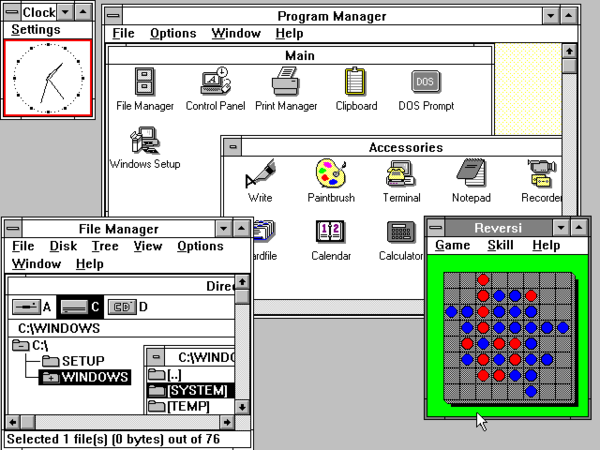Microsoft Windows

Microsoft Windows1 is a series of graphical interface operating systems developed, marketed and sold by the tech-giant "Microsoft". It launched its first product on November 20, 1985 in the form of Windows 1.0.
Windows 1.0

Windows 1.02 came out as the competitor of Apple's operating system "Apple Lisa". It was announced in November 1983 but eventually came out two years later. Its development was spearheaded by Microsoft founder Bill Gates, after seeing a demonstration at COMDEX 1982 of Visi On, a graphical user interface software suite for IBM PC compatibles. Presenting the windows on 10 November, 1983, Microsoft described the software as a device driver for MS-DOS 2.0. It required 256 KB of RAM, two floppy disk drives and a graphics adapter card. According to Bill Gates, the founder of the company, "It is unique software designed for the serious PC user". Instead of typing new commands, you just had to move the cursor and click your way through the screens. Windows 1.0 didnot allow overlapping windows. Instead they were tiled and only dialog boxes could appear over other windows.
Windows 1.0 got mixed reviews. Some people criticized it for its demanding system requirements while others appreciated the fact that it it included a new concept - Using a mouse as a navigation tool. Contemporary technology publications, even after acknowledging its overall importance in windows history line, regarded the version as a flop. It was succeeded by windows 2.0, that came out in the year 1987. Windows 1.0 was officially declared obsolete and unsupported by Microsoft on 31 December, 2001.
Windows 2.0

Windows 2.03, a 16-bit GUI-based operating environment, came out on 9 December, 1987 as a successor to windows 1.0. It had alot of improvements as compared to the previous version, the most note-worthy of which were more sophisticated keyboard shortcuts, overlapping windows and the terminology of Minimize and Maximize. It was also the first windows version to integrate control panel.
Windows 2.0 included VGA Graphics and was the last version that didnot require a hard disk. It was the also the version on which the first versions of Microsoft Word and Excel ran. It came out with various applications some of which were Paint.exe (a raster graphic editor), Calc.exe (A calculator) Terminal.exe (A terminal amulator) Write.exe (A simple word processor) and Notepad.exe (A text editor). This version of the windows, unlike its predecessor, got good reviews. Apple filed a lawsuit against Microsoft accusing them of violating copyrights held by apple. They claimed that windows had the same icons as the "look and feel" of the Macintosh operating system. The judge, however, ruled it in the favor of Microsoft. Windows 2.0 was followed by Windows 2.1x that came out a year later. It was declared unsupported by Microsoft on 31 December 2001.
Windows 2.1x

Windows 2.1x came out, in the form of two versions - Windows/286 and Windows/386, on May 27, 1988. It was the first version of the windows that required a hard disk to install.
Windows/286
Windows/286 introduced HIMEM.SYS DOS driver to increase the memory available to Windows programs. Despite its name, Windows/286 was fully operational on an 8088 or 8086 processor. It included support for several EMS boards. The segmented nature of windows programs was quite suited to the EMS as portions of code and data can be visible in the first megabyte of memory accessible to real-mode programs only when the program using them is given control.
Windows/386
Windows/386 introduced a protected mode kernel, above which the GUI and applications run as a virtual 8086 mode task. It also provided EMS simulation using the memory management features of the 80386 to make RAM beyond 640k behave like the banked memory previously only supplied by add-in cards and used by popular DOS applications. Neither of the versions ( 286 or 386) worked with DOS memory managers. They were succeeded by Windows 3.0 that came out in 1990. This too like its predecessors got declared obsolete on 31 December 2001.
Windows 3.0

Windows 3.04, the third major release of Microsoft, was released on May 22, 1990. It was the first window that gained so much success that it became a rival to Macintosh and the commodore Amiga on the GUI front. Its features included significantly revamped User Interface as well as technical improvements in order to make better use of the memory management capabilities if Intel's 80286 and 80386 processors. It also included a number of simple applications some of which were inherited from the earlier versions. It also included a Protected mode which allowed windows to use memory in a more painless manner than their DOS counterparts could.
Windows 3.0 required 6-7 MB of free space, MS DOS version 3.1 or higher, VGA Graphics and a compatible monitor, 8086/8088 processor or better and 384 KB of free conventional memory. Windows 3.0 was the only version of windows that could run in three memory modes - Real Mode, Standard Mode and Enhanced mode. Real mode was intended for computers with a CPU below Intel 80286. Standard mode was for computers with an 80286 processor and Enhanced mode was intended for newer computers with an Intel 80386 processor or above. Normally it started in the highest operating mode that the computer could use but the user was allowed to force it into lower modes by using DOS command prompt.
In December 1990, Microsoft released an update to this window, Windows 3.0a. Based on it, Windows 3.0 with multimedia extensions 1.0 was released in October 1991 to support soundcards as well as CD ROM drives that were becoming increasingly available. This edition added basic multimedia support for audio input and output, alongwith new applications. These new features were not accessible in Windows 3.0 real mode.
Windows 3.0 was the first version to see widespread use and significantly spurred sales of new PC's RAM capacities as older machines lacked the speed and memory to handle a demanding OS like windows. This version too got unsupported by 31 December 2001 by Microsoft.
External Links
- [Visited on 06/11/14] Microsoft HOMAPAGE
- [Visited on 06/11/14] Windows 1.0
- [Visited on 06/11/14] Windows 2.0
- [Visited on 06/11/14] Windows 3.0
- [Visited on 06/11/14] Image for Windows 1
- [Visited on 06/11/14] Image for Windows 2
- [Visited on 06/11/14] Image for Windows 2.x
- [Visited on 06/11/14] Image for Windows 3
- [Visited on 06/11/14] Windows Logo